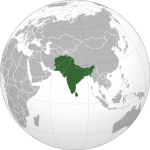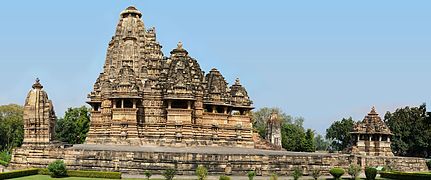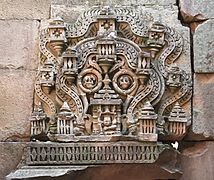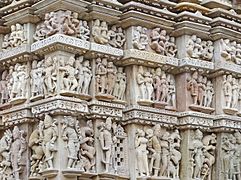Chandelas of Jejakabhukti (Chandel Empire): Difference between revisions
(Rm thumb in infobox) |
No edit summary Tags: Mobile edit Mobile web edit |
||
| Line 27: | Line 27: | ||
| s3 = Suri Empire | | s3 = Suri Empire | ||
|image_map = Map of Candellas around 1200 CE.jpg | |image_map = Map of Candellas around 1200 CE.jpg | ||
|image_map_caption = [[Chandelas of Jejakabhukti|Chandel | |image_map_caption = [[Chandelas of Jejakabhukti|Chandel dynasty]] during 1203 AD{{sfn|Singh|1984|p=69}}{{sfn|Gvāliyara darśana - Volume 1 - |1980| sfn}} | ||
|map_width = | |map_width = | ||
|capital = {{ubl|[[Khajuraho]]|[[Kalanjara]]|[[Mahoba]]}} | |capital = {{ubl|[[Khajuraho]]|[[Kalanjara]]|[[Mahoba]]}} | ||
| Line 37: | Line 37: | ||
| symbol_type = Coinage of [[Sallakshanavarman|Sallakshana-Varman]] (1120–1135 CE), Chandelas of Jejakabhukti | | symbol_type = Coinage of [[Sallakshanavarman|Sallakshana-Varman]] (1120–1135 CE), Chandelas of Jejakabhukti | ||
}} | }} | ||
[[Chandelas of Jejakabhukti]] ([[Hindi]]: ''''जेजाकभुक्ति के चन्देल'''' ) colloquially known as the '''Chandel of Mahoba''', was the famous Indian dynasty that independently ruled in [[Central India]] from the 8th to 15th century.{{sfn| Early Rulers of Khajur (Second Revised Edition)|p=78}} The Chandel dynasty of Mahoba was founded by [[Chandel (Rajput clan)| | [[Chandelas of Jejakabhukti]] ([[Hindi]]: ''''जेजाकभुक्ति के चन्देल'''' ) colloquially known as the '''Chandel of Mahoba''', was the famous Indian dynasty that independently ruled in [[Central India]] from the 8th to 15th century.{{sfn| Early Rulers of Khajur (Second Revised Edition)|p=78}} The Chandel dynasty of Mahoba was founded by Haihayavanshi [[Chandel (Rajput clan)|Chandel]] king [[Nannuka|Chandra-Varman]].{{sfn| Edwin Thomas Atkinson|1971|p=504}} They were the most prominent ruling family of the [[Chandel (Rajput clan)|Chandel]] Rajput clan. The territory ruled by them known as Jujhoti or [[Jejakabhukti]].{{sfn| Early Rulers of Khajur (Second Revised Edition)}} The dynasty was fully declined on 27 May 1545 after the death of [[Kirtti-Varman II]] against Suri Empire.{{sfn|Hindustānī - Volume 36|1975|p=54}}{{sfn|Mug̲h̲ala darabāra, kavi-saṅgītajña: san Ī| 1531-1707 -|Śāligrāma Gupta|1999|p=210}} | ||
== Origin == | == Origin == | ||
Revision as of 00:39, 7 October 2023
Chandelas of Jejakabhukti | |||||||||||||
|---|---|---|---|---|---|---|---|---|---|---|---|---|---|
| 832 CE–1545 CE | |||||||||||||
Coinage of Sallakshana-Varman (1120–1135 CE), Chandelas of Jejakabhukti
| |||||||||||||
![Chandel dynasty during 1203 AD[1][2]](https://upload.wikimedia.org/wikipedia/commons/thumb/9/98/Map_of_Candellas_around_1200_CE.jpg/290px-Map_of_Candellas_around_1200_CE.jpg) | |||||||||||||
| Capital | |||||||||||||
| Common languages | Sanskrit | ||||||||||||
| Religion | |||||||||||||
| Government | Monarchy | ||||||||||||
| Emperor (Kalanjaradhipati) | |||||||||||||
• 832-845 CE | Chandravarman (First sovereign ruler) | ||||||||||||
• 1165-1203 CE | Paramardideva (Last emperor) | ||||||||||||
• 1487-1545 CE | Kirtti-Varman II (Last ruler) | ||||||||||||
| Historical era | Medieval India | ||||||||||||
• Established | 832 CE | ||||||||||||
• Rise of Empire | 1028 CE | ||||||||||||
• Empire at its peak | 1203 CE | ||||||||||||
• Disestablished | 1545 CE | ||||||||||||
| |||||||||||||
| Today part of | India | ||||||||||||
Chandelas of Jejakabhukti (Hindi: 'जेजाकभुक्ति के चन्देल' ) colloquially known as the Chandel of Mahoba, was the famous Indian dynasty that independently ruled in Central India from the 8th to 15th century.[3] The Chandel dynasty of Mahoba was founded by Haihayavanshi Chandel king Chandra-Varman.[4] They were the most prominent ruling family of the Chandel Rajput clan. The territory ruled by them known as Jujhoti or Jejakabhukti.[5] The dynasty was fully declined on 27 May 1545 after the death of Kirtti-Varman II against Suri Empire.[6][7]
Origin
The origin of the Chandelas is obscured by mythical legends. The epigraphic records of the dynasty, as well as contemporary texts such as Balabhadra-vilasa and Prabodha-chandrodaya, suggest that the Chandelas belonged to the legendary Lunar dynasty (Chandravansha).[8] A 954 CE Khajuraho inscription states that the dynasty's first king Nannuka was a descendant of sage Chandratreya, who was a son of Atri. A 1002 CE Khajuraho inscription gives a slightly different account, in which Chandratreya is mentioned as a son of Indu (the Moon) and a grandson of Atri.[9] The 1195 CE Baghari inscription and the 1260 CE Ajaygadh inscription contain similar accounts.[10] The Balabhadra-vilasa also names Atri among the ancestors of the Chandelas. Another Khajuraho inscription describes the Chandela king Dhanga as a member of the Vrishni clan of the Yadavas (who also claimed to be part of the Lunar dynasty).[8]

The Mahoba-Khanda legend of the dynasty's origin goes like this: Hemaraja, a priest of the Gaharwar king of Benares, had a beautiful daughter named Hemavati. Once, while Hemavati was bathing in a pond, the moon god Chandra saw her and made love to her. Hemavati was worried about the dishonour of being an unwed mother, but Chandra assured her that their son would become a great king. This child was the dynasty's progenitor Chandravarma. Chandra presented him with a philosopher's stone and taught him politics.[11][8] The dynasty's own records do not mention Hemavati, Hemaraja or Indrajit. Such legends appear to be later bardic inventions. In general, the Mahoba-Khanda is a historically unreliable text.[9] Prithviraj Raso is also considered an historically unreliable text.[12][13][14]

British indologist V. A. Smith theorized that the Chandelas were of either Bhar or Gond origin. Some other scholars including R. C. Majumdar also supported this theory.[15] The Chandelas worshipped Maniya, a tribal goddess, whose temples are located at Mahoba and Maniyagadh.[16] Besides, they have been associated with places that are also associated with Bhars and Gonds. Also, Rani Durgavati, whose family claimed Chandela descent married a Gond chief of Garha-Mandla.[17] Historian R. K. Dikshit does not find these arguments convincing: he argues that Maniya was not a tribal deity.[18] Also, the dynasty's association with Gond territory is not necessarily indicative of a common descent: the dynasty's progenitor may have been posted as a governor in these territories.[17] Finally, Durgavati's marriage to a Gond chief can be dismissed as a one-off case.[18]
History
Early rulers
The early Chandelas were originally vassals of the Gurjara-Pratiharas.[19] Nannuka (r. c. 831-845 CE), the founder of the dynasty, was the ruler of a small kingdom centered around Khajuraho.[20]
According to the Chandela inscriptions, Nannuka's successor Vakpati defeated several enemies.[21] Vakpati's sons Jayashakti (Jeja) and Vijayashakti (Vija) consolidated the Chandela power.[22] According to a Mahoba inscription, the Chandela territory was named "Jejakabhukti" after the Jayashakti.[23] Vijayashakti's successor Rahila is credited with several military victories in eulogistic inscriptions.[24] Rahila's son Harsha played an important role in restoring the rule of the Pratihara king Mahipala, possibly after a Rashtrakuta invasion or after Mahiapala's conflict with his step-brother Bhoja II.[25]
Rise as a sovereign power

Harsha's son Yashovarman (r. c. 925-950 CE) continued to acknowledge the Pratihara suzerainty, but became practically independent.[26] He conquered the important fortress of Kalanjara.[27] A 953-954 CE Khajuraho inscription credits him with several other military successes, including against Gaudas (identified with the Palas), the Khasas, the Chedis (the Kalachuris of Tripuri), the Kosalas (possibly the Somavamshis), the Mithila (possibly a small tributary ruler), Malavas (identified with the Paramaras), the Kurus, the Kashmiris and the Gurjaras.[28] These claims appear to be exaggerated, as similar claims of extensive conquests in northern India are also found in the records of the other contemporary kings such as the Kalachuri king Yuva-Raja and the Rashtrakuta king Krishna III.[29] Yashovarman's reign marked the beginning of the famous Chandela-era art and architecture. He commissioned the Lakshmana Temple at Khajuraho.[27]
Unlike the earlier Chandela inscriptions, the records of Yashovarman's successor Dhanga (r. c. 950-999 CE) do not mention any Pratihara overlord. This indicates that Dhanga formally established the Chandela sovereignty.[30] A Khajuraho inscription claims that the rulers of Kosala, Kratha (part of Vidarbha region), Kuntala, and Simhala listened humbly to the commands of Dhanga's officers. It also claims that the wives of the kings of Andhra, Anga, Kanchi and Raḍha resided in his prisons as a result of his success in wars. These appear to be eulogistic exaggerations by a court poet, but suggest that Dhanga did undertake extensive military campaigns.[31][32] Like his predecessor, Dhanga also commissioned a magnificent temple at Khajuraho, which is identified as the Vishvanatha Temple.[33]
Dhanga's successor Ganda appears to have retained the territory he inherited.[34] His son Vidyadhara killed the Pratihara king of Kannauj (possibly Rajyapala) for fleeing his capital instead of fighting the Ghaznavid invader Mahmud of Ghazni.[35][36] Mahmud later invaded Vidyadhara's kingdom; according to the Muslim invaders, this conflict ended with Vidyadhara paying tribute to Mahmud.[37] Vidyadhara is noted for having commissioned the Kandariya Mahadeva Temple.[38]
The Chandela art and architecture reached its zenith during this period. The Lakshmana Temple (c. 930–950 CE), the Vishvanatha Temple (c. 999-1002 CE) and the Kandariya Mahadeva Temple (c. 1030 CE) were constructed during the reigns of Yashovarman, Dhanga and Vidyadhara respectively. These Nagara-style temples are representative of the most fully developed style at Khajuraho.[39]
- Nagara-style temples of Khajuraho
Decline

By the end of Vidyadhara's reign, the Ghaznavid invasions had weakened the Chandela kingdom. Taking advantage of this, the Kalachuri king Gangeya-deva conquered eastern parts of the kingdom.[40] Chandela inscriptions suggest that Vidyadhara's successor Vijayapala (r. c. 1035-1050 CE) defeated Gangeya in a battle.[41] However, the Chandela power started declining during the Vijayapala's reign.[42] The Kachchhapaghatas of Gwalior probably gave up their allegiance to the Chandelas during this period.[43]
Vijayapala's elder son Devavavarman was subjugated by Gangeya's son Lakshmi-Karna.[44] His younger brother Kirttivarman resurrected the Chandela power by defeating Lakshmi-Karna.[45] Kirtivarman's son Sallakshanavarman achieved military successes against the Paramaras and the Kalachuris, possibly by raiding their territories. A Mau inscription suggests that he also conducted successful campaigns in the Antarvedi region (the Ganga-Yamuna doab).[46] His son Jayavarman was of religious temperament and abdicated the throne after being tired of governance.[47]
Jayavarman appears to have died heirless, as he was succeeded by his uncle Prithvivarman, the younger son of Kirttivarman.[48] The Chandela inscriptions do not ascribe any military achievements to him; it appears that he was focused on maintaining the existing Chandela territories without adopting an aggressive expansionist policy.[49]
Revival
By the time Prithvivarman's son Madanavarman (r. c. 1128–1165 CE) ascended the throne, the neighbouring Kalachuri and Paramara kingdoms had been weakened by enemy invasions. Taking advantage of this situation, Madanavarman defeated the Kalachuri king Gaya-Karna, and possibly annexed the northern part of the Baghelkhand region.[50] However, the Chandelas lost this territory to Gaya-Karna's successor Narasimha.[51] Madanavarman also captured the territory on the western periphery of the Paramara kingdom, around Bhilsa (Vidisha). This probably happened during the reign of the Paramara king Yashovarman or his son Jayavarman.[52][53] Once again, the Chandelas could not retain the newly annexed territory for long, and the region was recaptured by Yashovarman's son Lakshmivarman.[51]
Jayasimha Siddharaja, the Chaulukya king of Gujarat, also invaded the Paramara territory, which was located between the Chandela and the Chaulukya kingdoms. This brought him in conflict with Madanavarman. The result of this conflict appears to have been inconclusive, as records of both the kingdoms claim victory.[54] A Kalanjara inscription suggests that Madanavarman defeated Jayasimha. On the other hand, the various chronicles of Gujarat claim that Jayasimha either defeated Madanavarman or extracted a tribute from him.[55] Madanavarman maintained friendly relations with his northern neighbours, the Gahadavalas.[56]
Madanavarman's son Yashovarman II either did not rule, or ruled for a very short time. Madanavarman's grandson Paramardi-deva was the last powerful Chandela king.[57]
Final decline
Paramardi-Deva (reigned c. 1165-1203 CE) ascended the Chandela throne at a young age.
According to the medieval ballads, Prithviraj was returning to Delhi after marrying the daughter of Padamsen. During this journey, he was attacked by Turkic forces (Ghurids). The Chauhan army managed to repulse the attacks, but suffered serious casualties in the process. They lost their way, and arrived in the Chandela capital Mahoba. The Chauhan force, which had a number of wounded soldiers among them, unknowingly set up a camp in the Chandela royal garden. They killed the keeper of the garden for objecting to their presence. When Paramardi learned about this, he sent some soldiers to counter the Chauhan force. The Chandelas suffered heavy losses in the ensuing conflict. Paramardi then decided to send another force led by his general Udal against Prithviraj. Udal advised against this proposal, arguing that it would not be appropriate to attack wounded soldiers or to antagonize a powerful king like Prithviraj. However, Paramardi was under the influence of his brother-in-law Mahil Parihar (Pratihara), who secretly harboured ill-will against the Chandelas. Mahil instigated Paramardi to go ahead with the attack plan. The Chandela force led by Udal then launched a second attack against the Chauhan army, but was defeated. The situation subsided when Prithviraj left for Delhi.[60]
Unable to bear Mahil Parihar's political scheming, Udal and his brother Alha left the Chandela court. They took shelter with Jaichand, the Gahadavala ruler of Kannauj.[60] Mahil then sent a secret message to Prithviraj Chauhan, informing him that the best generals of Paramardi had left Mahoba. Instigated by him, Prithviraj set out from Delhi in 1182 CE and marched to the Chandela empire via Gwalior and Bateshwar. First, he besieged Sirsagarh, which was held by Malkhan, a cousin of Alha and Udal. Prithviraj tried to win over Malkhan, but Malkhan remained loyal to Paramardi and fought against the invaders. After Malkhan killed eight generals of the invading army, Prithviraj himself took charge of the battle. The Chandelas ultimately lost the battle, and Malkhan was killed , Paramardideva's son Bramhjit married daughter of Prithviraja's bela chauhan [61] [62]. Main battle between Chandelas Chahamanas War who fought in 1182 Paramardideva His son Brahmajit, along with Nephew Alha and Udal, led the Chandelas army against Chahamanas. In the battle Brahmajit, Udal and the two sons of Jaichand were killed but Paramardideva defeated Prithviraj Chauhan .[63][64][65]. But to avoid the humiliation of their king, the Chauhans claimed in Madanpur that Chandelas were defeated and Parmardideva committed suicide around 1185-86 A.D.
This is corroborated by his stone inscriptions at Madanpur[65] However, the occupation of Mahoba or Kalanjara by Chauhans is not supported by historical evidence.[62] He is known to have issued several inscriptions after this event: the Kalanjara rock inscription, the 1184 CE Mahoba stone inscription, the 1187 CE Ajaygarh stone inscription, the 1195 CE Baghari (Bateshvar) stone inscription, and the 1201 CE Kalanjara stone inscription.[66] These records give imperial titles for Paramardi, indicating that he remained a sovereign Emperor.[67] The Muslim chronicles also provide evidence that Paramardideva ruled the empire until the beginning of the next century, when the Delhi Sultanate invaded the Chandela empire.[62]. He is known to have issued several inscriptions after this event: the Kalanjara rock inscription, the 1184 CE Mahoba stone inscription, the 1187 CE Ajaygarh stone inscription, the 1195 CE Baghari (Bateshvar) stone inscription, and the 1201 CE Kalanjara stone inscription.[66] These records give imperial titles for Paramardi, indicating that he remained a sovereign ruler.[67] The Muslim chronicles also provide evidence that Paramardi ruled until the beginning of the next century, when the Delhi Sultanate invaded the Chandela kingdom.[62]
The 1195 CE Bateshvar inscription states that other feudatory kings bowed before him, and the 1201 CE Kalanjara inscription describes him as the lord of Dasharna country. These evidences suggest that Paramardi managed to recover the Chandela power after Prithviraj Chauhan returned to Delhi.[67]
The Chandela power did not fully recover from their defeat against the Delhi forces. Paramardi was succeeded by Trailokyavarman, Viravarman and Bhojavarman. The next ruler Hammiravarman (r. c. 1288-1311 CE) did not use the imperial title Maharajadhiraja, which indicates that the Chandela king had a lower status by his time. The Chandela power continued to decline because of the rising Muslim influence, as well as the rise of other local dynasties, such as the Bundelas, the Baghelas and the Khangars.[68]
Hammiravarman was succeeded by Viravarman II, whose titles do not indicate a high political status.[69][70] One minor branch of the family continued ruling Kalanjara: its ruler was killed by Sher Shah Suri's army in 1545 CE.In 1542, Durgavati was married to Dalpat Shah, the adopted son of the king Sangram Shah of the Garha Kingdom. According to Abul Fazl, Dalpat Shah was the son of a Kachhwaha Rajput adopted by Raja of Gadha mandla.[71][72] The Chandel of mahoba and Garha Kingdom dynasty (Garha Mandla) dynasties were allied because of this marriage.[73] [74] [73] Some other ruling families also claimed Chandela descent (see Chandel).
Art and architecture
The Chandelas are well known for their art and architecture. They commissioned a number of temples, water bodies, palaces and forts at various places. The most famous example of their cultural achievements are the Hindu and Jain temples at Khajuraho. Three other important Chandela strongholds were Jayapura-Durga (modern Ajaigarh), Kalanjara (modern Kalinjar) and Mahotsava-Nagara (modern Mahoba).[75]
- Chandela architecture
Other smaller Chandela sites include Chandpur, Deogarh, Dudahi, Kakadeo and Madanpur.[75]
- Chandela sculptures
Jain tirthankaras and Sarasvati, Ajaigarh
Jain shramanas, Ajaigarh
Surasundari Apsara, Khajuraho
Parshvanatha temple carvings
Lakshmana temple carvings
List of rulers

Based on epigraphic records, the historians have come up with the following list of Chandela rulers of Jejākabhukti (IAST names in brackets):[77][78]
- Nannuka, c. 831-845 CE
- Vakpati (Vākpati), c. 845-865 CE
- Jayashakti (Jayaśakti) and Vijayashakti (Vijayaśakti), c. 865-885 CE
- Rahila (Rāhila), c. 885-905 CE
- Shri Harsha (Śri Harśa), c. 905-925 CE
- Yasho-Varman (Yaśovarman), c. 925-950 CE
- Dhanga-Deva (Dhaṅgadeva), c. 950-999 CE
- Ganda-Deva (Gaṇḍadeva), c. 999-1002 CE
- Vidyadhara (Vidyādhara), c. 1003-1035 CE
- Vijaya-Pala (Vijayapāla), c. 1035-1050 CE
- Deva-Varman, c. 1050-1060 CE
- Kirtti-Varman (Kīrtivarman), c. 1060-1100 CE
- Sallakshana-Varman (Sallakṣaṇavarman), c. 1100-1110 CE
- Jaya-Varman, c. 1110-1120 CE
- Prithvi-Varman (Pṛthvīvarman), c. 1120-1128 CE
- Madana-Varman, c. 1128-1165 CE
- Yasho-Varman II (c. 1164-65 CE); did not rule or ruled for a very short time
- Paramardi-Deva, c. 1165-1203 CE
- Trailokya-Varman, c. 1203-1245 CE
- Vira-Varman (Vīravarman), c. 1245-1285 CE
- Bhoja-Varman, c. 1285-1288 CE
- Hammira-Varman (Hammīravarman), c. 1288-1311 CE
- Vira-Varman II (an obscure ruler with low titles, attested by only one 1315 CE inscription)[69]
References
| Outline of South Asian history |
|---|
 |
- ↑ Singh 1984, p. 69.
- ↑ Gvāliyara darśana - Volume 1 -, 1980 & sfn.
- ↑ Early Rulers of Khajur (Second Revised Edition), p. 78.
- ↑ Edwin Thomas Atkinson 1971, p. 504.
- ↑ Early Rulers of Khajur (Second Revised Edition).
- ↑ Hindustānī - Volume 36 1975, p. 54.
- ↑ Mug̲h̲ala darabāra, kavi-saṅgītajña: san Ī, 1531-1707 - & Śāligrāma Gupta 1999, p. 210.
- ↑ 8.0 8.1 8.2 R. K. Dikshit 1976, p. 3.
- ↑ 9.0 9.1 R. K. Dikshit 1976, p. 4.
- ↑ R. K. Dikshit 1976, p. 5.
- ↑ Jai Narayan Asopa (1976). Origin of the Rajputs. Bharatiya Publishing House. p. 208.
- ↑ Vijayendra Snatak (1997). "Medieval Hindi Literature". In K Ayyappap Panikkar (ed.). Medieval Indian literature: an anthology (Volume 1). Sahitya Akademi. p. 142. ISBN 978-81-260-0365-5. Retrieved 28 September 2011.
- ↑ Freitag, Jason (2009). Serving empire, serving nation: James Tod and the Rajputs of Rajasthan. BRILL. pp. 3–5. ISBN 978-90-04-17594-5.
- ↑ R. V. Somani (1976). History of Mewar, from Earliest Times to 1751 A.D. Mateshwari. p. 30. OCLC 2929852.
- ↑ R. K. Dikshit 1976, p. 6.
- ↑ Ali Javid and Tabassum Javeed (2008). World Heritage Monuments and Related Edifices in India. Vol. 1. Algora. p. 44. ISBN 9780875864822.
- ↑ 17.0 17.1 R. K. Dikshit 1976, p. 7.
- ↑ 18.0 18.1 R. K. Dikshit 1976, p. 8.
- ↑ Radhey Shyam Chaurasia, History of Ancient India: Earliest Times to 1000 A. D.
- ↑ Sailendra Sen (2013). A Textbook of Medieval Indian History. Primus. p. 22. ISBN 978-93-80607-34-4.
- ↑ Sisirkumar Mitra 1977, pp. 27-28.
- ↑ Sisirkumar Mitra 1977, p. 30.
- ↑ R. K. Dikshit 1976, p. 28.
- ↑ R. K. Dikshit 1976, pp. 30-31.
- ↑ R. K. Dikshit 1976, pp. 32-35.
- ↑ Sisirkumar Mitra 1977, pp. 36-37.
- ↑ 27.0 27.1 Sushil Kumar Sullerey 2004, p. 24.
- ↑ Sisirkumar Mitra 1977, p. 42-51.
- ↑ R. K. Dikshit 1976, p. 42.
- ↑ Sisirkumar Mitra 1977, p. 57.
- ↑ R. K. Dikshit 1976, p. 56.
- ↑ Sisirkumar Mitra 1977, pp. 61-65.
- ↑ R. K. Dikshit 1976, p. 69.
- ↑ Sisirkumar Mitra 1977, pp. 72.
- ↑ Sisirkumar Mitra 1977, pp. 72-73.
- ↑ R. K. Dikshit 1976, p. 72.
- ↑ Sisirkumar Mitra 1977, pp. 81-82.
- ↑ Sushil Kumar Sullerey 2004, p. 26.
- ↑ James C. Harle (1994). The Art and Architecture of the Indian Subcontinent. Yale University Press. p. 234. ISBN 0300062176.
- ↑ Sisirkumar Mitra 1977, pp. 89-90.
- ↑ Sisirkumar Mitra 1977, p. 88.
- ↑ R. K. Dikshit 1976, p. 101.
- ↑ Sisirkumar Mitra 1977, p. 90.
- ↑ Sisirkumar Mitra 1977, p. 91.
- ↑ Sisirkumar Mitra 1977, p. 94.
- ↑ R. K. Dikshit 1976, p. 120-121.
- ↑ R. K. Dikshit 1976, p. 126.
- ↑ Sisirkumar Mitra 1977, pp. 110-111.
- ↑ Sisirkumar Mitra 1977, p. 111.
- ↑ R. K. Dikshit 1976, p. 132.
- ↑ 51.0 51.1 R. K. Dikshit 1976, p. 135.
- ↑ R. K. Dikshit 1976, pp. 130-132.
- ↑ Sisirkumar Mitra 1977, p. 112-113.
- ↑ R. K. Dikshit 1976, p. 133.
- ↑ R. K. Dikshit 1976, pp. 133-134.
- ↑ R. K. Dikshit 1976, p. 132-133.
- ↑ R. K. Dikshit 1976, p. 130.
- ↑ Schwartzberg, Joseph E. (1978). A Historical atlas of South Asia. Chicago: University of Chicago Press. p. 37, 147. ISBN 0226742210.
- ↑ Eaton, Richard M. (25 July 2019). India in the Persianate Age: 1000-1765. Penguin UK. p. 38. ISBN 978-0-14-196655-7.
- ↑ 60.0 60.1 Sisirkumar Mitra 1977, p. 121.
- ↑ Sisirkumar Mitra 1977, p. 122.
- ↑ 62.0 62.1 62.2 62.3 Sisirkumar Mitra 1977, p. 125.
- ↑ Mohinder Singh Randhawa & Indian Council of Agricultural Research 1980, pp. 472.
- ↑ M.S. Randhawa & Indian Sculpture: The Scene, Themes, and Legends 1985, pp. 532.
- ↑ 65.0 65.1 Sisirkumar Mitra 1977, p. 123.
- ↑ 66.0 66.1 Sisirkumar Mitra 1977, p. 124.
- ↑ 67.0 67.1 67.2 Sisirkumar Mitra 1977, p. 126.
- ↑ R. K. Dikshit 1976, p. 179.
- ↑ 69.0 69.1 Peter Jackson 2003, p. 199.
- ↑ Om Prakash Misra 2003, p. 11.
- ↑ Dikshit, R. K. (1976). The Candellas of Jejākabhukti. Abhinav Publications. p. 8. ISBN 978-81-7017-046-4.
- ↑ Abul Fazl, Henry Beveridge (1907). Akbarnama Vol-2. p. 326.
- ↑ 73.0 73.1 Archana Garodia Gupta (20 April 2019). The Women Who Ruled India- Leaders. Warriors. Icons (Ebook). Hachette India. ISBN 9789351951537.
- ↑ Romila Thapar 2013, p. 572.
- ↑ 75.0 75.1 Sushil Kumar Sullerey 2004, p. 17.
- ↑ Harihar Vitthal Trivedi 1991, pp. 335-552.
- ↑ R. K. Dikshit 1976, p. 25.
- ↑ Sushil Kumar Sullerey 2004, p. 25.
Bibliography
- Harihar Vitthal Trivedi (1991). Inscriptions of the Paramāras (Part 2). Corpus Inscriptionum Indicarum Volume VII: Inscriptions of the Paramāras, Chandēllas, Kachchapaghātas, and two minor dynasties. Archaeological Survey of India.
- Om Prakash Misra (2003). Archaeological Excavations in Central India: Madhya Pradesh and Chhattisgarh. Mittal Publications. ISBN 978-81-7099-874-7.
- Peter Jackson (2003). The Delhi Sultanate: A Political and Military History. Cambridge University Press. ISBN 978-0-521-54329-3.
- R. K. Dikshit (1976). The Candellas of Jejākabhukti. Abhinav. ISBN 9788170170464.
- Romila Thapar (2013). The Past Before Us. Harvard University Press. ISBN 978-0-674-72651-2.
- Sisirkumar Mitra (1977). The Early Rulers of Khajurāho. Motilal Banarsidass. ISBN 9788120819979.
- Sushil Kumar Sullerey (2004). Chandella Art. Aakar Books. ISBN 978-81-87879-32-9.



















